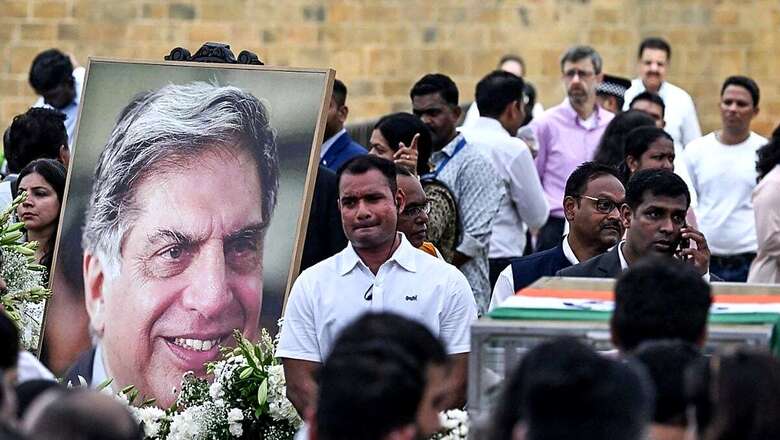
views
Is India a Hindu-first majoritarian country? There are fringe extremists among Hindus who are communal. But the vast majority of ordinary Hindus bear no animosity towards Muslims — or indeed towards any minority community.
Every persecuted community sought and found refuge in India. India’s historical tolerance of different faiths has long been recognised around the world.
Parsis fled Islamic persecution in Iran 13 centuries ago. They came to India — they did not seek refuge in any other country to the west or north of Iran. They knew that the safest haven for them lay in India. Their fire temples and faith have remained undisturbed in India for 13 centuries.
Parsis have repaid India’s generosity by being exemplary citizens, contributing to India’s development far in excess of their numbers. Ratan Tata is only one of several generations of Parsis who have served India — from Dadabhai Naoroji to Field Marshal Sam Maneckshaw.
When Christians arrived in India soon after the birth of Jesus Christ, they were welcomed on the Malabar Coast. As time went by, they set up churches and educational institutions in Kerala and elsewhere, creating prosperity and inclusiveness in their new homeland. Like Parsis, Christians adapted to Indian ways.
Jews fleeing persecution in Europe and the Middle East too found refuge in India’s southern states, living in peace with Muslims and Christians amid a Hindu majority.
It was only after the beginning of the colonial era that trouble visited India. The Portuguese were especially violent. The Inquisition in Goa from the 16th century onwards created a chasm between Hindus and Christians who had till then lived together in harmony. The communalisation of Goa’s social fabric was caused not by India’s innate secular ethos but by Portugal’s communal violence that fractured relations between Hindus and Christians for centuries.
Many Muslims had fled their holy lands after the internecine battles between Sunnis and breakaway Shias in the 7th and 8th centuries. Muslims, like early Parsis, Jews and Christians, sought and received refuge in India. But the advent of foreign Islamic armies in northwest India caused violent clashes with local Hindu rulers. Once again communalism was injected into Indian society from overseas. And once again, the peaceful social fabric of India was torn apart.
Communal politics
What has changed in recent decades is the deliberate communalisation of Indian politics. Since Independence, Muslims were told: you are special; you have special rights. The intent was not just to win Muslim votes (though that was regarded as a collateral benefit) but to maintain communal peace.
After the trauma of Partition, the Jawaharlal Nehru government sought to appease Muslims instead of empowering them. But appeasement is cosmetic. It delivers no significant economic benefit to the appeased. It is a palliative to mitigate unrest, not provide modern education to Muslims.
The rise of Hindutva began in the early 1900s. The RSS was founded by Keshav Baliram Hedgewar in 1925. But decades before that Lokmanya Bal Gangadhar Tilak had raised the flag of Hindu renaissance after centuries of subjugation by foreign invaders, Muslim and Christian.
Has the rise of the RSS led to majoritarianism in India?
Societies are resilient. Top-down communalisation is difficult to achieve. Despite the growing social power of the Sangh parivar and its affiliates, India remains a resolutely secular nation. In a poor country of 1.45 billion, communal riots are rare. Violence against Hindu minorities in Muslim-majority areas like Kashmir and parts of West Bengal does occur but these incidents too are increasingly isolated.
The majority of Hindus vote against the BJP. In three Lok Sabha elections between 2014 and 2024, the BJP recorded vote shares of 31 per cent, 37.36 per cent and 36.56 per cent respectively. The average: less than 35 per cent.
The governor of Tamil Nadu, RN Ravi, said recently that secularism is a European concept, separating state and church. In India, there is no such separation. Consider Ravi’s exact remark: “In Europe, secularism came because there was a fight between the church and the king. In India, there is no need for secularism.”
Ravi errs when he dismisses the concept of Indian secularism.
Indian secularism needs to be rescued from the fraudulent definition it has been given by political parties that preach secularism but practise communalism dressed up as secularism.
Empower, don’t appease
In the book Love Jihad and Other Fictions by Sreenivasan Jain, Mariyan Alavi and Supriya Sharma, the authors mix up appeasement with empowerment. The authors argue that if Muslims had been appeased, as Hindutva critics say they have, they would not be India’s poorest, most backward community according to the Sachar Committee and Misra Commission reports.
Thus, the authors argue, Muslims have not been “appeased”. This displays a staggering ignorance of what appeasement is: it is disempowerment by promising faith-based benefits rather than economic upliftment and empowerment. Muslims, contrary to the authors’ bizarre understanding of the English language, have indeed been appeased. That is why they are India’s most backward community.
What India needs is not the abandonment of secularism but a better understanding of secularism.
When Indians gave refuge to persecuted Parsis, Jews, Muslims and Christians, India demonstrated the true meaning of secularism. Appeasement is the antithesis of secularism. Empowerment is the bedrock of real secularism.
Muslims in India suffer on two counts. First, they are misled by their religious leaders who teach them a medieval interpretation of Islam. Second, they are appeased by political parties pretending to be guardians of Islamic rights but are only interested in their votes.
Despite these provocations, the majority of India’s 80 per cent Hindu population has not succumbed to majoritarianism. The millions who mourned Ratan Tata — ordinary Hindus, Muslims, Christians and Parsis — instinctively understood that.
The writer is an editor, author and publisher. Views expressed in the above piece are personal and solely those of the author. They do not necessarily reflect News18’s views.




















Comments
0 comment